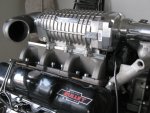- 168
- 174
- 43
- Location
- Hills of / TN
Has anyone tried to bolt on a procharger instead of using a turbo?( Im thinking of using one on a 6.5) I don't think it would be too difficult install But what say you.. Thanks Bruhs
Steel Soldiers now has a few new forums, read more about it at: New Munitions Forums!




Keith, I was very plain in my post that I had no desire or intent to start a debate. And I will not engage with you on the subject. I do know that actual results override theory, and the engineers at Bullet have the results. This is the system they use on cross-Australia racing. You have the God-given right to believe (or doubt) anything you want to, but please do not try to force your beliefs (or doubts) on me. This will be my last post in this thread.How does the Bullet system match boost to fuel rate? If the vehicle is doing road speed with 1/4 throttle yet the boost is 15 PSI, there is a far excess of air which not only consumes 15 HP to produce, it also lowers the efficiency of combustion. And increases oxides of nitrogen.
The indirect injected diesel is most inefficient at idle. Here, excess air is present and flame duration is entirely in the precombustion chamber. This is why these diesels warm up fast as all flame is in the head. And why they have a particular exhaust smell, all from incomplete combustion. The 6.2 engine requires double the fuel to idle than a similar sized direct injection diesel.
Turbochargers designed correctly for diesels are heat powered devices and as such, vary supplied boost pressure based on the fuel rate. A positive displacement supercharger would require a variable ratio transmission based on throttle position. I've only seen this on an old centrifugal blower found on Kaiser Manhattan, the McCullough VS57. It used a V belt drive with a split sheave and spring tensioner. The low efficiency of a positive displacement supercharger precludes variable speed drive.
I don't doubt the Bullet system works. But I doubt it provides anything but high fuel consumption at listed power levels.

